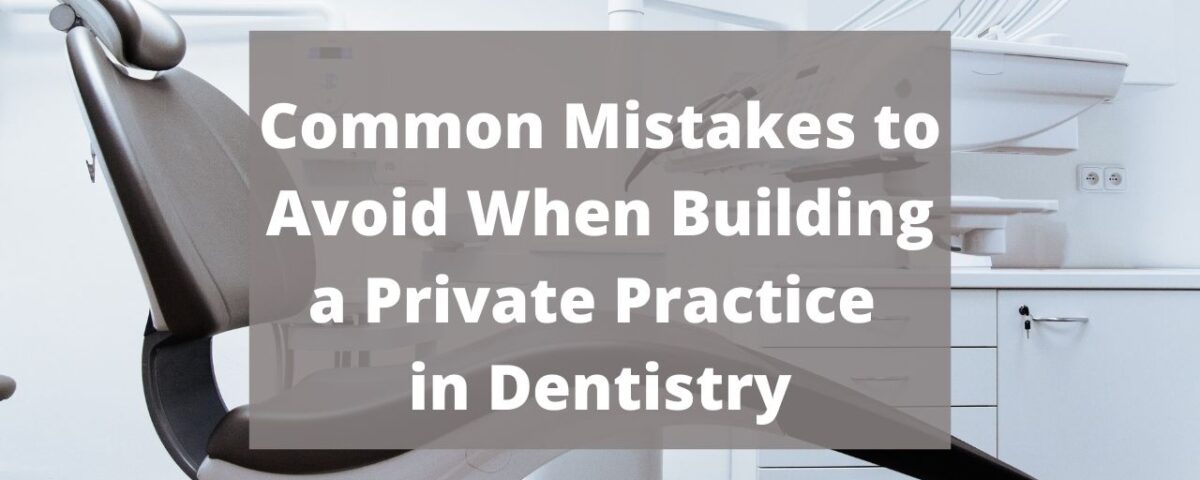Starting a dental practice can be an enduring and trying experience. With startup costs, new business responsibilities, and the transition from employee to being your own boss, it can be a lot. To help get you a head start on your journey, we’ve compiled a list of the most common mistakes to avoid when building a private practice in dentistry.
Underestimating the cost
At the end of the day, your practice is a business, and with any business, there are very high startup costs.
On average, the startup expenses for owners of a dental clinic are more than $430,000. However, this cost can reach almost a million dollars depending on the size, specialty, and location of your practice. Keep in mind, that most of the cost goes towards renting and supplying the office itself.
However, the startup costs for a dental office go beyond just equipment and rent. You’ll also have to shell out a decent amount of cash for adequate staffing, software, a solid website, marketing materials, and more. The early stages of starting a practice are going to be the most expensive. Whether you’re starting a practice from scratch, or buying into an existing one, understanding your financial responsibility for any liabilities or assets is key. Even if you’re buying a
Business Loans
Unless you have half a million dollars in your savings, you’re most likely going to have to take out a loan. The most common financing option is a business loan. With a small business loan, you can get a large sum of money that will satisfy the cost of starting a clinic. It also allows you to get a head start in building business credit. However, getting a business loan can be difficult and can come with drawbacks such as higher interest rates and restrictions on what the money can be used towards.
If you own a home, you may want to consider funding part of your practice with a home equity loan. Using a home equity loan has a quicker application process, fewer restrictions, and lower interest rates, which can save you money in the long run. Although there are benefits to this, it’s important to remember that, with any loan, there are risks. In this case, you risk foreclosure if you’re not able to pay your home equity loan back. Once you understand your budget and where you stand financially, you can decide what financing option is best for you.
Not having an emergency fund
Along with having the proper start-up money, it’s important to have an established emergency fund.
Throughout your private practice journey, you’ll undoubtedly hit some bumps along the way. Having a safety net of set aside funds will help put your mind at ease when any obstacles come your way.
Deciding how much money to put in your emergency fund differs from person to person. Many will say to have 6 months of business costs saved. However, to make sure you don’t over or underspend, it’s important to assess your current situation and how these potential risks can affect your business’s revenue. Taking the time to map out potential threats to the clinic, understand how they’ll affect the business, and predict how they’ll affect your personal life will help you better understand how much money to save.
In addition to an emergency fund, it’s also good to save money as a financial buffer. When starting a practice, it can be hard to gain a steady stream of patients. Not only that, but patients will cancel or miss appointments. To safeguard yourself from potential dips in revenue, it’s key to have a financial buffer to help stay afloat.
Putting little effort into marketing
You could have the best skills in all of dentistry, but if no one knows about your clinic, then you won’t succeed.
Before you open up to the public, establish a clear brand. Think of your message. Who are you? Why should patients trust you? What do you offer that your competitors don’t? Building your brand will help establish trust and loyalty among your target audience. It’ll also set clear guidelines on how you advertise, market, and communicate with your patients.
Marketing your brand is key, as it makes it easier for people to find your clinic and become established patients. There are many platforms you can use to get your clinic’s name out there. Investing in advertising, whether it be billboards, posters, guerilla marketing, etc., can be beneficial but costly. Luckily, we live in a digital age where you can reach large audiences for less money. For starters, consider putting your private practice in dental directories. Paying a small fee to get on these sites can help patients easily find your practice. Another way to have patients find your site is through blogging.
As well as having a website, it’s important to have a blog that uses specific keywords and phrases. Having this in place will help increase SEO and contribute to raising your page ranks, making it easier for patients to find your site and learn more about your offerings. Lastly, social media can be a great way to share information and engage with new and existing patients at little to no cost. With social media, you can advertise to specific target audiences based on interests, demographics, and location. You can even set your budget and time frame beforehand, so you don’t overspend. Getting your practice’s name out there will help generate new patients and separate you from competitors.
Forgetting about patient experience
Once you get an inflow of patients, you must work to retain them. This means giving them a reason to want to use your services again. One way of ensuring that patients come back is by making the patient experience as positive as possible.
Spend time cultivating an efficient and positive patient experience. Maybe this means investing in scheduling software for a more seamless service. For example, you can go digital with dental practice management software. Many practices use integrated digital platforms that have patient files, billing & coding, and patient scheduling made for physicians. This helps keep filing to a minimum, with no physical paper trail, lost documents, or patient charts. It helps your practice run smoothly with a seamless, integrated design that also makes you and your employees more efficient, giving your patients satisfying experiences.
Regardless of how efficient your practice is, there will inevitably be patients waiting for their appointment. Put yourself in your patients’ shoes. Their first and last experience is in the waiting room. Take note of what that experience is like. Is it a nuisance, or is it efficient? Are they being greeted, or are they being ignored? Invest in proper staff and decor to make the waiting room a welcoming and comfortable place for your patients. Implementing basic practices such as keeping the place clean, having optimal temperatures, soothing music, and entertainment options can help create a better waiting room experience.
Not taking the time to hire and train staff
Your staff represent your brand and are a big part of the patient experience. Happy employees tend to correlate with better customer service.
Take the time to hire and train the right people. You can do this by being a part of the interview process yourself. Look at experience and personality, as these are the people that’ll interact with your patients the most. Take the time to create a training budget so your staff is well equipped with the knowledge and protocols they need to deal with any customer situation.
Be sure to also help encourage the growth of your staff members. Have frequent check-ins to hear how your staff members are doing. Set up goals with them to keep them motivated. Listen to their needs and help to best accommodate them when necessary. Investing the time and resources into your dental staff will create a strong team. Keeping your team motivated and engaged will help to improve productivity and create an overall positive experience.
Being closed-minded and refusing to adapt
Just like your employees, you also need to grow your knowledge and be ready to adapt as needed.
Expand your knowledge by attending trade shows to understand the new trends and technology in dentistry. Follow dental blogs to learn about new business trends, industry updates, and the latest dental technology available. No one is perfect, and there is always room for improvement. Rather than being behind, stay ahead of the game by taking the time to learn.
You should also work to be open-minded and gather feedback. Communicate with your front-line staff to see what they’re observing and experiencing. Give patients access to a safe space, whether it’s a survey or anonymous comment section where they can voice their opinion. Look at reviews to see how people are talking about your business. Taking inventory of peoples’ opinions will allow you to see where there are holes and opportunities to adapt and grow your practice.
Forgetting that growth takes time
Like anything, growth takes time. It’s easy to get lost in the costs and hustle of it all, but don’t lose sight of your goal.
As important as it is to set long-term goals, it’s equally as essential to set yourself some specific and attainable short-term goals. This will help you stay motivated and keep you on a path toward success.
Starting a private practice is tough, but not impossible. If you’re patient, have clear goals, listen to your audience, and are willing to adapt, success will fall into place – it’ll just take time.
For more tips on building your own private practice, check out How to Start a Dental Practice from Safco.






